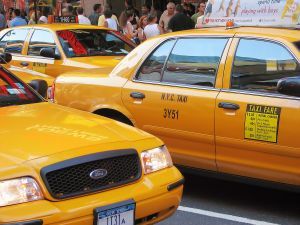Are you planning a trip to New York City and anticipating a number of yellow taxi cab rides? Perhaps you’re a city resident who already uses taxis, but you don’t know all the little rules associated with riding? The yellow taxi cabs in New York City are thoroughly regulated, with policies sometimes different than those in other large cities. According to the Schaller Consulting’s Taxicab Fact Book, nearly 13,000 NYC taxis provided rides to over 241 million passengers in 2005 alone. With such volume, you know that New York has the taxi business down to a science.
Here are 20 things you should know about yellow taxi cabs in New York City, with the most basic points first.
1. Service Type. Yellow Taxi Cabs in New York City CANNOT be called in advance; they can only be hailed on the street or approached at a taxi stand. Many tourists do not realize this. If you want a for-hire vehicle to pick you up at a specific location, you have to use a different kind of service, and separate rates will apply.
2. Receipt. You should always get a receipt, even if you’re not planning to get reimbursed for the ride by an employer. The reason? Your receipt records the medallion number and time, in case you need to make a complaint or you realize you left a belonging in the cab.
3. Regular Fare Structure. $2.50 is the starting fare, with each 1/5 of a mile costing 40 cents. There is also an idle time rate for each minute the cab is stopped in traffic (defined as moving less than 6 miles and hour).
4. Night and Peak Surcharges. Between 8:00pm, and 6:00am, there is a night surcharge of 50 cents that applies every day of the week. During the Monday through Friday workweek, there is also a Peak Hour surcharge of $1.00 for rides between 4:00pm and 8:00pm, as this is obviously the most hectic taxi time.
5. Occupancy. Yellow taxi cabs can accommodate up to four passengers. The only circumstance under which more than four passengers are allowed is when an adult (who must be seated in the back) keeps a child under age 7 on his/her lap. And are you ready for some good news? There is no extra charge for additional riders in NYC yellow taxicabs. [Chicago cab users are not so lucky, as they pay a surcharge for every extra rider.]
6. Multiple Destinations. There is often much confusion over whether a cab driver is required to accept a fare that involves multiple destinations. If you want a ride from, say, the Port Authority to Battery Park with a quick stop at your East Village apartment, the driver still has to accept your fare. Of course, you are responsible for the taximeter charges the whole way, and that idle time adds up quickly!
7. Credit Cards. As of early 2006, there is a pilot program for credit card use available in just over 150 cabs (a mere fraction of the operating yellow taxis). The city is still evaluating whether it will be feasible or worthwhile to equip all yellow taxicabs with credit card terminals
8. Riding in the Front Seat. You are allowed to ride in the front seat, but only if you cannot be accomodated in the usual rear passenger area. This most commonly occurs when four larger-than-average people can’t squish into the back seat.
9. Radio-Free Rides. One of the items on the NYC taxi rider’s “Bill of Rights” addresses music within the cab. Riders are guaranteed a radio-free trip if they so desire. If the driver already has the radio on, and you want silence, just ask them to turn it off and they should comply immediately. Of course, if you want to listen to the radio, many cab drivers will be happy to accommodate, knowing that you may tip them more generously.
10. Air-Conditioning. Even if your cabbie doesn’t think it’s hot enough for AC, you have the right to request air conditioning. Most yellow taxi drivers try to keep their cabs comfortable, especially during the sweltering urban summers. They know that a cool ride will make for a better tip anyway.
11. Smoke and Incense-Free Rides. This should go without saying, but just in case you weren’t sure, you do have the right to ride without tobacco smoke or burning incense.
12. Refusals. Like most other cities, New York has a refusal law stating that on-duty cab drivers may not deny rides within the five boroughs of the city. So if you are in midtown Manhattan and need to go to the far reaches of Queens, the driver can’t give you any flack. Additionally, drivers are forbidden from discriminating against riders based on race, disability, or destination point. If you are headed to a neighborhood the cabbie finds objectionable or unsafe, they are required to taxi you there anyway.
13. Route. You can specify the route if you know where you are going, and the driver is required to comply with your request. If you assert a specific route, though, you’d better be darn sure about it. Otherwise, you could end up paying more than you expected (which is what you were probably trying to avoid by giving such expicit instructions).
14. Tolls. You are responsible for tolls, which will always be paid with the cab’s EZ Pass and then incorporated into your fare. If it’s any consolation, you do receive the discounted EZ Pass toll rate.
14. JFK Airport. There is a flat fee of $45 (plus tolls) for trips from anywhere in Manhattan to JFK airport. In fact, the taximeter is turned off for the trip, and you will pay not stopped traffic charges or other surcharges. However, remember that the reverse trip from JFK to destinations in Manhattan is NOT a flat fee. Appropriate meter charges will apply.
15. Laguardia Airport. Unlike fares to JFK from Manhattan, taxi fares to Laguardia are not flat. Regular taximeter charges apply.
16. Newark Airport. Yellow cab trips to Newark Airport from most parts of Manhattan will be expensive because the driver must leave New York City proper. As with trips to Laguardia, the regular taximeter charges will apply – plus tolls AND a $15 special surcharge. (You may want to consider taking the PATH trains if you’re concerned about saving money.)
17. File a complaint. It’s fast and easy to file a complaint about a driver or another aspect of your New York City taxicab experience. Simply go online to www.nyc.gov and look for the TLC (Taxi and Limousine Commission). Possible complaints include: overcharges, dangerous driving, refusal of service, rudeness, and failure to take a direct route – just to name a few. If you feel the situation is serious enough, you actually have the opportunity to attend a hearing to make your case in person against the driver. Remember that you will need the medallion number (visible both inside and outside the vehicle and on your receipt).
18. Lost Items. Thousands of items are left in NYC taxicabs each year. You can launch a lost property inquiry on www.nyc.gov. It helps, once again, to have the medallion number.
19. Tips. It is customary to tip about 15%, though the usual range is anywhere from 10% to 20%, depending on the level of service. If you do feel that the cab driver violated your passenger “bill of rights,” you are encouraged (according to the TLC) not to tip at all.
20. NYC Cabbie. Just for kicks, check out www.nyccabbie.com, a website containing photos, stories, and other tidbits about New York City taxi subculture. It’s maintained by a real yellow taxicab driver.



